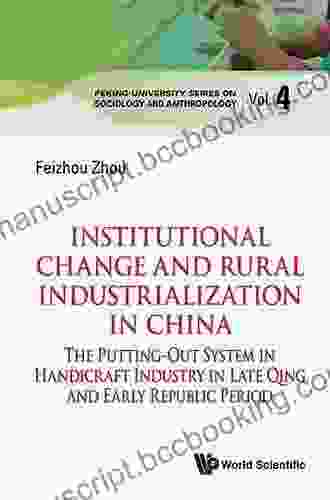Institutional Change and Rural Industrialization in China: Unlocking Rural Economic Potential

China's economic transformation over the past few decades has been nothing short of remarkable. While urbanization and industrialization have played a significant role in this growth, rural areas have often lagged behind. However, recent years have seen a resurgence of interest in promoting rural industrialization as a means to address regional disparities and enhance overall economic development. Institutional change has emerged as a key driver of this renewed focus, providing a framework for policies and initiatives that support rural enterprises and foster economic growth in these regions.
Institutional Framework for Rural Industrialization
Institutions play a crucial role in shaping rural development. They provide a set of rules, regulations, and norms that govern economic activities and influence the behavior of individuals and organizations. In the context of rural industrialization, institutional change has been instrumental in creating an enabling environment for businesses to thrive and contribute to economic growth.
4.6 out of 5
| Language | : | English |
| File size | : | 5458 KB |
| Text-to-Speech | : | Enabled |
| Screen Reader | : | Supported |
| Enhanced typesetting | : | Enabled |
| Word Wise | : | Enabled |
| Print length | : | 203 pages |
Key institutional changes have included:
- Land tenure reforms: Relaxation of land use restrictions and the establishment of land markets have facilitated the development of rural industrial zones and provided access to land for industrial activities.
- Financial liberalization: Increased availability of financial services, including microfinance and rural credit cooperatives, has expanded access to capital for rural entrepreneurs and small businesses.
- Investment in infrastructure: Improvements in transportation, communication, and energy infrastructure have reduced transaction costs, improved logistics, and enhanced connectivity between rural areas and urban markets.
- Education and skills development: Investments in education and vocational training have upgraded the skills of the rural workforce and provided the necessary human capital for industrialization.
Policy Support for Industrialization
In addition to institutional reforms, government policies have played a proactive role in promoting rural industrialization. These policies have focused on:
- Attracting investment: Tax incentives, subsidies, and preferential land policies have been implemented to encourage businesses to invest in rural areas.
- Supporting small and medium enterprises (SMEs): Government programs have provided financial support, technical assistance, and market access to SMEs, which form the backbone of rural industrialization.
- Developing industrial clusters: The promotion of specialized industrial clusters, where related industries are concentrated, has fostered innovation, knowledge sharing, and supply chain efficiencies.
- Enhancing rural infrastructure: Continued investment in transportation, energy, and communication infrastructure has further reduced barriers to industrialization and improved the quality of life in rural communities.
Economic Impacts of Rural Industrialization
The institutional changes and supportive policies have led to significant economic benefits for rural areas:
- Job creation: Rural industrialization has created numerous employment opportunities for the rural workforce, reducing unemployment and underemployment.
- Income growth: Increased industrial activities have boosted incomes and living standards in rural communities, narrowing the gap with urban areas.
- Balanced regional development: By promoting industrialization in rural areas, China has addressed regional disparities and fostered a more balanced economic development across the country.
- Reduced poverty: Industrialization has provided a sustainable pathway out of poverty for many rural households, reducing income inequality and improving overall well-being.
Challenges and Future Prospects
While rural industrialization has made significant progress, challenges remain:
- Capacity constraints: Firms in rural areas often face challenges with technology adoption, innovation, and management skills.
- Market access: Rural enterprises may struggle to access urban markets and compete with well-established urban businesses.
- Environmental sustainability: Industrialization can bring environmental challenges that need to be addressed through responsible practices and regulations.
Overcoming these challenges will require continued institutional reforms, supportive policies, and investments in human capital and infrastructure. The future of rural industrialization in China lies in embracing innovation, sustainability, and collaboration among government, businesses, and communities.
Institutional change has played a transformative role in driving rural industrialization in China. By creating an enabling environment, supporting entrepreneurship, and investing in infrastructure and education, China has unlocked the economic potential of rural areas. The positive impacts on employment, income, and regional development are a testament to the effectiveness of these strategies. As China continues its economic journey, further institutional reforms, policy support, and investments will be essential to sustain and enhance the benefits of rural industrialization, promoting inclusive growth and prosperity across the nation.
4.6 out of 5
| Language | : | English |
| File size | : | 5458 KB |
| Text-to-Speech | : | Enabled |
| Screen Reader | : | Supported |
| Enhanced typesetting | : | Enabled |
| Word Wise | : | Enabled |
| Print length | : | 203 pages |
Do you want to contribute by writing guest posts on this blog?
Please contact us and send us a resume of previous articles that you have written.
 Book
Book Novel
Novel Page
Page Chapter
Chapter Text
Text Story
Story Genre
Genre Reader
Reader Library
Library Paperback
Paperback E-book
E-book Magazine
Magazine Newspaper
Newspaper Paragraph
Paragraph Sentence
Sentence Bookmark
Bookmark Shelf
Shelf Glossary
Glossary Bibliography
Bibliography Foreword
Foreword Preface
Preface Synopsis
Synopsis Annotation
Annotation Footnote
Footnote Manuscript
Manuscript Scroll
Scroll Codex
Codex Tome
Tome Bestseller
Bestseller Classics
Classics Library card
Library card Narrative
Narrative Biography
Biography Autobiography
Autobiography Memoir
Memoir Reference
Reference Encyclopedia
Encyclopedia Felix R Savage
Felix R Savage Fiona Peart
Fiona Peart Fiston Mudacumura
Fiston Mudacumura Tom Gasek
Tom Gasek Evan Purcell
Evan Purcell Jeanne Filler Scott
Jeanne Filler Scott Katherine Roy
Katherine Roy Michael Walker
Michael Walker Faythe Levine
Faythe Levine Evan Currie
Evan Currie William S Mcfeely
William S Mcfeely Deborah Ball
Deborah Ball Triumphant Test Prep
Triumphant Test Prep Ethan Lou
Ethan Lou First Edition Kindle Edition
First Edition Kindle Edition Faya Causey
Faya Causey Sabatino Moscati
Sabatino Moscati Evan S Connell
Evan S Connell Lazarus Lynch
Lazarus Lynch James Joyce
James Joyce
Light bulbAdvertise smarter! Our strategic ad space ensures maximum exposure. Reserve your spot today!

 Stephen FosterEmbark on a Wild Adventure with Sticks: A Comprehensive Guide to Unlocking...
Stephen FosterEmbark on a Wild Adventure with Sticks: A Comprehensive Guide to Unlocking...
 Isaiah PowellThe Misadventures of Awkward Black Girl: A Hilarious and Heartwarming Novel...
Isaiah PowellThe Misadventures of Awkward Black Girl: A Hilarious and Heartwarming Novel... Ervin BellFollow ·3k
Ervin BellFollow ·3k August HayesFollow ·8.7k
August HayesFollow ·8.7k Jean BlairFollow ·3.2k
Jean BlairFollow ·3.2k Braden WardFollow ·9k
Braden WardFollow ·9k William PowellFollow ·4k
William PowellFollow ·4k Stephen FosterFollow ·5.7k
Stephen FosterFollow ·5.7k Rudyard KiplingFollow ·2.7k
Rudyard KiplingFollow ·2.7k Alvin BellFollow ·18.7k
Alvin BellFollow ·18.7k

 W.H. Auden
W.H. AudenStep into a World of Thrilling Deception: Don Blink by...
Unveiling the Masterpiece of Suspense:...

 Jaylen Mitchell
Jaylen MitchellUnleash Your Creativity with "This Easy Origami": A...
: Embark on an Enchanting Voyage into the...

 Vladimir Nabokov
Vladimir NabokovEmpowering Home Births: A Comprehensive Guide for Fathers...
An In-Depth Exploration of Paternal...

 Juan Rulfo
Juan RulfoThe Maya Exodus: Indigenous Struggle for Citizenship in...
The Maya Exodus: Indigenous Struggle for...

 Julio Ramón Ribeyro
Julio Ramón RibeyroKana Made Easy: Dive into Japanese the Fun and Effortless...
Unveiling the Secrets...
4.6 out of 5
| Language | : | English |
| File size | : | 5458 KB |
| Text-to-Speech | : | Enabled |
| Screen Reader | : | Supported |
| Enhanced typesetting | : | Enabled |
| Word Wise | : | Enabled |
| Print length | : | 203 pages |










